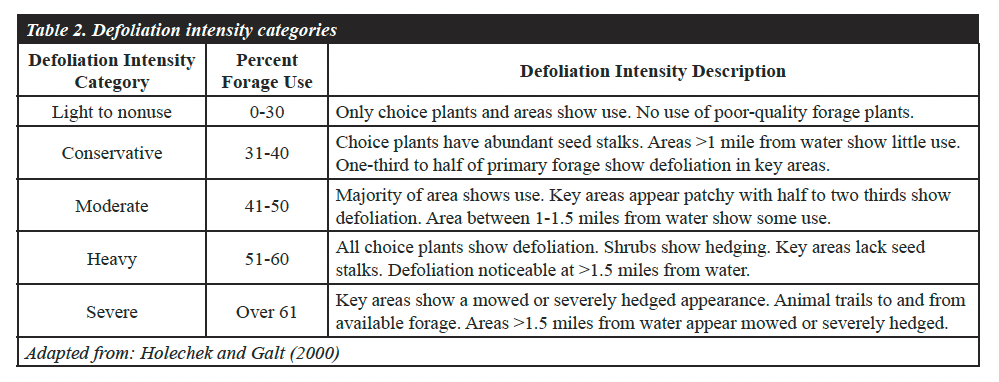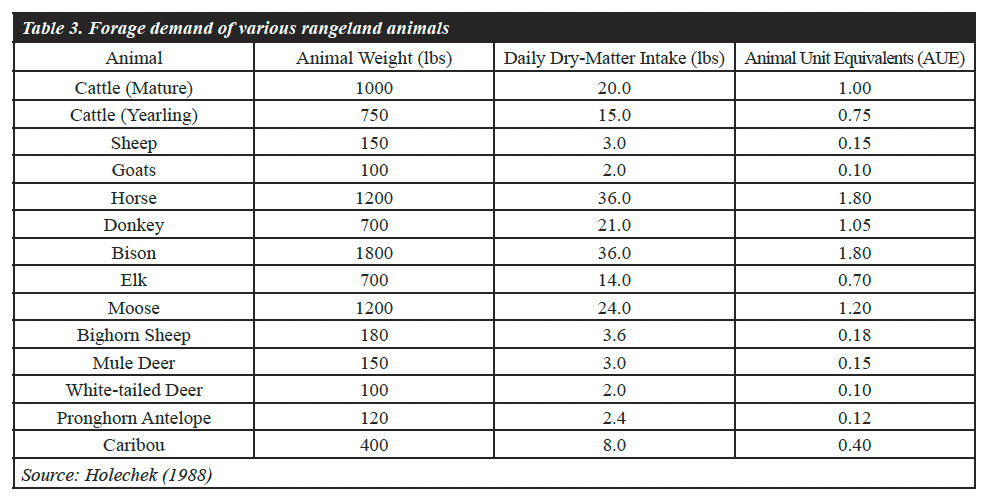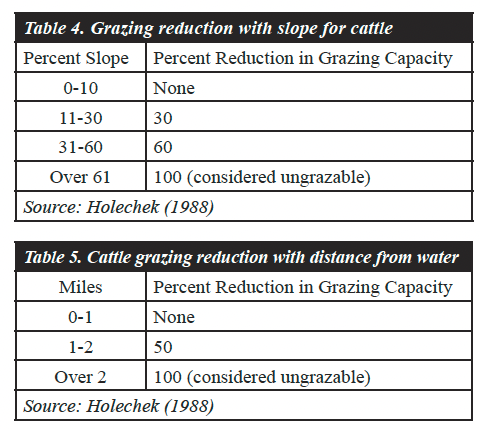Guide B-829
Casey Spackman and Marcy Ward
College of Agricultural, Consumer and Environmental Sciences, New Mexico State University
Author: Respectively, Extension Range Specialist and Extension Livestock Specialist, Department of Extension Animal Sciences and Natural Resources. (Print-Friendly PDF)
INTRODUCTION
Carrying capacity is defined as the average number of wild and domestic animals that a landscape or area can support. Monitoring is the method by which landscape assessments can be made and determines whether the trajectory of rangeland conditions is improving, sustaining, or degrading. Calculating carrying capacity from monitoring data is critical to avoid the overuse of natural resources. Understanding basic concepts of the calculation process can help provide a more accurate estimate of carrying capacity and promote sustainable rangeland conditions.
SITE SELECTION
Selecting monitoring areas representative of the landscape is key for site selection. Understandably, rangeland pastures vary greatly across the landscape, and certain factors may contribute to the under or over-representation of vegetation present. Thus, some general factors should be considered when selecting an assessment site. Because animals tend to congregate around infrastructure and look for easy travel pathways, it is suggested to select areas a quarter to one mile from water sources, fences, roadways, and other manmade structures. Additionally, selecting sites with slopes less than 15% and areas of greater than 5 acres is recommended.
FORAGE QUANTITIES

Photo 1. Forage production collection. (Courtesy Casey Spackman.)
The amount of forage available for animals is determined by collecting sub-samples of vegetation from a given area with the sub-sample size known. Samples are then dried, weighed, and converted to pounds of forage per acre (Table 1). The following equation can calculate the total available forage:
Available forage in pounds (lbs) per acre × pasture size in acres
Available forage data can be assessed by residual or annual forage production. Residual forage is plant material collected with possible defoliation from animals (Photo 1). This type of assessment should only be used to estimate current forage availability, not a yearly cumulative total. Annual forage production is plant material collected from exclusion cages and used to assess cumulative forage production for the year (Photo 2). When annual forage assessments are taken over 5-10 years, trends can be established to make long-term management decisions, whereas 3-5 years of data can be used to make short-term management decisions. Residual forage assessments can be taken at any time during the year, while annual forage estimates are to be taken at the end of the growing season.

UTILIZATION
The percentage of forage removed by animals or the amount of residual vegetation remaining after consumption is referred to as utilization. Utilization is only an approximation of forage use or an estimate of defoliation intensity (Table 2). When residual and annual forage production data is available, the two can be used to deduce an estimate of percent utilization. The following is an equation to estimate percent utilization:
(annual forage production – residual forage) ÷ annual forage production
Light to conservative defoliation in New Mexico optimizes vegetation production and animal productivity, whereas moderate to heavy defoliation can lead to rangeland deterioration if intensity persists over the long term.

FORAGE DEMAND
Animals consume, on average, 2% of their body weight daily on a dry matter basis. Intake of ruminants may be higher or lower depending on forage quality and stage
of production (NASEM, 2016). Horses and donkeys can consume up to 50% more forage per day due to variations in their digestive system. Forage demand standardizes the number of animals a pasture can support through animal unit equivalents (AUE). One mature cow of 1000 pounds, either dry or with calf up to six months of age, is considered one AUE. There is considerable variation between agencies in calculating AUE across different animals. For instance, North Dakota State University bases AUE on metabolic weight rather than dry matter intake (Manske, 1998). However, basing AUE off dry matter intake can give a general estimate and suffice in calculating carrying capacity. Rangeland animals and their unit equivalents on a dry matter basis can be found in Table 3.

LANDSCAPE ADJUSTMENTS
For livestock, several parameters limit the utilization of forages across the landscape. It is important to consider these elements when estimating carrying capacity. For instance, as distance from water or slope increases, vegetation use decreases. The exception is domestic goats and sheep, which do not require water daily and can forage more readily on rugged terrain. Cattle on the other hand, tend to graze flatter terrain and stay closer to water. Thus, tables 4 and 5 give recommended grazing adjustment for cattle only. For domestic sheep and goats, distances less than 2 miles from water and slopes less than 45 percent are used at 100 percent. There can be a significant overlap of slope and distance from water in adjustment calculations, thus, these should be calculated separately with the greatest reduction percent used. They should not be combined for a cumulative reduction. The following are equations used after preliminary carrying capacity has been estimated:
WATER: (% area <1 mile × 1)+(% area 1-2 miles × 0.5)+(% area 2+ miles × 0) × AUE
SLOPE: (% area 0-10% × 1)+( % area 11-30% × 0.6)+( % area 31-60% × 0.3)+( % area >60% × 0)] × AUE

CARRYING CAPACITY CALCULATION
Once total available forage quantities, desired utilization, and animal forage demand is known, carrying capacity can be calculated. Animal unit equivalents of domestic animals can be adjusted for duration and are standardized as animal unit day (AUD; one day only), animal unit month (AUM; 30 days), and animal unit year (AUY; 365 days),
while wildlife is calculated as AUY only. For livestock, if a pasture has a specified grazing duration (e.g., leases or allotments), AUE can be adjusted by multiplying animal forage demand by the specified time period, expressed as animal units per designated days. The following is a generalized equation for a single animal type used to estimate carrying capacity, followed by examples:
(total available forage × percent utilization) ÷ (animal forage demand) = AUE
EXAMPLE 1: A 20,000-acre cattle ranch produces a yearly average of 550 lbs of forage per acre. Utilization of 35% is desired. The ranch uses a year-long continuous grazing system (365 days).
total available forage = 20,000 acres × 550 lbs = 11,000,000 lbs
animal forage demand = 20 lbs per day × 356 days = 7300 lbs
AUY = (11,000,000 lbs × 0.35) ÷ 7300 lbs = 527 AUY
EXAMPLE 2: Using the same ranch from example 1, 60% of the acreage has water available to cattle within 1 mile, 30% between 1 and 2 miles, and 10% over 2 miles.
(0.60 × 1)+(0.30 × 0.5)+(0.10 × 0) × 527 AUY = 395 AUY
EXAMPLE 3: Using the same ranch from example 1, 40% of the acreage has slopes less than 10%, 20% with slopes between 11 to 30%, 30% with slopes between 31 to 60%, and 10% with slopes greater than 60%.
(0.40 × 1)+( 0.20 × 0.60)+( 0.30 × 0.30)+( 0.10 × 0)] × 527 AUY = 321 AUY
LITERATURE CITED
Manske, L.L., 1998. Animal unit equivalent for beef cattle based on metabolic weight.
Holechek, J.L., 1988. An approach for setting the stocking rate.
Holechek, J.L., Galt, D., 2000. Grazing intensity guidelines. Rangelands 22, 11–14.
Manske, L.L., 1998. Animal unit equivalent for beef cattle based on metabolic weight.
National Academies of Sciences, Engineering, and Medicine (NASEM). 2016. Nutrient requirements of beef cattle, 8th revised ed. Washington, D.C.: The National Academies Press. Doi: 10.17226/19014.
Pratt, M., Rasmussen, G.A., 2001. Calculating available forage. https://digitalcommons.usu.edu/cgi/viewcontent.cgi?article=1991&context=extension_histall
For Further Reading
LPC-3: Is There Enough Grass? Balancing Forage Supply and Demand
https://pubs.nmsu.edu/specialty/lpc/LPC3/index.html
 Casey Spackman is an Assistant Professor and Extension Range Management Specialist at New Mexico State University. He earned his Ph.D. at Utah State University. His Extension efforts aim to assist producers, land managers, and agency personnel in monitoring and developing management objectives that maintain or improve natural resource health and sustainability.
Casey Spackman is an Assistant Professor and Extension Range Management Specialist at New Mexico State University. He earned his Ph.D. at Utah State University. His Extension efforts aim to assist producers, land managers, and agency personnel in monitoring and developing management objectives that maintain or improve natural resource health and sustainability.
To find more resources for your business, home, or family, visit the College of Agricultural, Consumer and Environmental Sciences on the World Wide Web at pubs.nmsu.edu
Contents of publications may be freely reproduced for educational purposes. All other rights reserved. For permission to use publications for other purposes, contact pubs@nmsu.edu.
New Mexico State University is an equal opportunity/affirmative action employer and educator. NMSU and the U.S. Department of Agriculture cooperating.
November 2023 Las Cruces, NM


